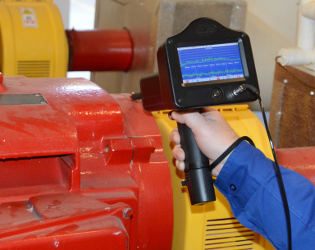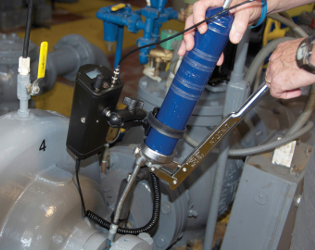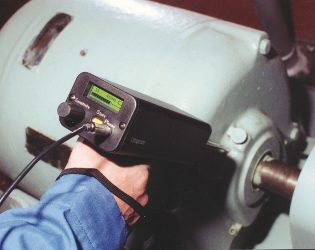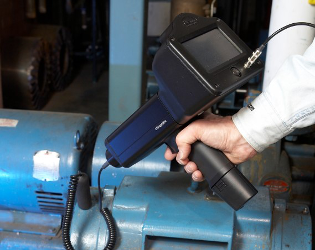Predictive & pro-active inspection of rotating equipment with an instrument such as the Ultraprobe has many advantages.
Avoid production downtime by anticipating bearing failures and preventing lubrication issues.

SLOW SPEEDUltrasound can be used on all bearing speeds – including on slow speed bearings,
as low as 1 RPM.

Avoiding over-LUBRICATION60 to 80% of bearing failures are lubrication-related. Identify a lack of lubrication and prevent over-lubrication.

REMOTE & ONLINE MONITORINGPermanent mounted ultrasonic sensors can monitor bearings 24/7. Create trends and setup alarm levels.
![]()




Advantages of Ultrasound for Bearing Condition Monitoring
An ultrasound bearing inspection program provides:
- Early warning of bearing failure
- Detecting a lack of lubrication
- Preventing over-lubrication
- Advanced software to assist your work process & efficient analysis
Ultrasound can be used on all bearing speeds (high, medium and low). In addition, since ultrasound is a high frequency, short wave signal, it is possible to filter out stray, confusing background noises and focus on the specific item to be inspected.
Basic inspection methods are extremely simple and require little training. For those who require more sophistication, UE Systems offers training courses that range from one-day classes, on-site implementation training to five-day certification courses.
The more sophisticated digital instruments provide features for comprehensive bearing condition monitoring programs:
- Data logging: DMS software for trending and setting of alarm parameters
- Data transmission of settings: for extremely fast route based data collection
- Sound sample recording: spectrum analysis for analysis and reporting
- Customizable reporting formats incorporating other parameters & images
- Data sharing: Software packages that work on a computer network
Key advantages of UE Systems Ultrasound Bearing program:
Ultrasound requires minimal training
- Implementation process is fast & integrates easily into existing programs
- Data Management Software easy to use and creates the reports you need
- For each level of engineers there is a program to fit your needs
- Transfer of existing programs is easy, making it sustainable long term
Software
- DMS and Spectralyser software packages are free!
- Regular updates available on this website for added reporting functions
Global presence & support
- Multinational sites can be supported locally
- Comparison of multiple plant data / benchmarking
- Technical support available to our customers
How ultrasound bearing inspection works
Ultrasound instruments detect friction
Mechanical movements produce a wide spectrum of sound. One of the major contributors to excessive stress in machinery is friction. By focusing on a narrow band of high frequencies, the Ultraprobe detects subtle changes in amplitude and sound quality produced by operating equipment. It then heterodynes these normally undetectable sounds down into the audible range where they are heard through headphones and observed on a display panel for trending, comparison, and analysis.
It has been established that ultrasound monitoring provides early warning of bearing failure. Various stages of bearing failure have been established:
- An 8 dB gain over baseline indicates pre-failure or lack of lubrication.
- A 12 dB increase establishes the very beginning of the failure mode.
- A 16 dB gain indicates advanced failure condition
- A 35-50 dB gain warns of catastrophic failure.
For those who utilize ultrasound spectral analysis, these conditions can often be observed through both FFT and time series analysis.
Ultrasonic Bearing Inspection Methods
There are three methods for ultrasonic bearing monitoring:
- Comparative: Compare same type of bearings and note deviations, easy & fast to do
- Historical: Establish a trend over time of measured values with the help of DMS Software
- Analytical: Utilize Spectralyzer software with the integrated bearing fault calculator
With the Historical method & using the DMS Software we are able to also program alarm levels in our data points:
- Establish a baseline reading
- 1st alarm = indication of lack of lubrication
- 2nd alarm = early warning of bearing failure
After an upload of new data from a route, reporting functions in the software will help you to produce a fast and easy lubrication report.
Bearing Lubrication with Ultrasound
As many as 60 to 80 percent of all bearing failures (catastrophic, functional and premature) are lubrication-related.
In addition to selecting the correct lubricant, use UE Systems’ ultrasound instruments to identify a lack of lubrication and prevent over lubrication conditions.
Set a baseline for each bearing, test routinely to note decibel increases. When a bearing reaches an 8 dB gain over baseline with no change in sound quality, it is in need of lubrication. When applying lubricant, stop when the dB level drops to baseline. It’s just that easy!
The UE Systems Grease Caddy is an instrument developed specifically for supporting your lubrication practices.
Advantages:
- Cost effective instrument for lubrication engineers
- Simple to operate
- Keeps your hands free to lubricate with the help of mounting bracket or belt holster
Bearings Remote & Online Monitoring
Remote Monitoring with RAS (Remote Access Sensors) & Switch Boxes
When accessibility is an issue, such as when a motor is contained within a closed cabinet, or a test point is in a hard-to-reach area, the Remote Access Sensor (RAS) is the answer.
Mount the RAS on the test point and run a cable to an access area where a RAM (Remote Access Module) can be connected. When the point is to be tested, plug the RAM into your Ultraprobe and take your reading. Installation is very simple and testing is really easy.
If you have multiple bearings on hard-to-reach areas, you can even make use of UE Systems’ Switch Boxes which will allow to test up to 8 bearings at once.
Connect and test single or multiple points remotely. Permanently mount a RAS to a test point and run a coax cable to the Switch Box. Once connected, you may test up to 8 test points at a time. To test, attach a RAM (Remote Access Module) to the Switchbox, select a test point indicator and collect your data. It’s that easy!
Online Monitoring with the 4Cast – Bearing Condition Monitoring System
Review bearing information from the convenience of your office. Monitor bearing condition 24/7 and tell 4Cast when to send a report. This unique system continuously logs bearing data and bearing sounds. At pre-set intervals, all stored data and sound samples are sent to a computer for reporting and analysis.
How often do you want 4Cast to sample a bearing? System flexibility allows users to pre-set how often a bearing will be tested: by the minute, hour, day, etc.
